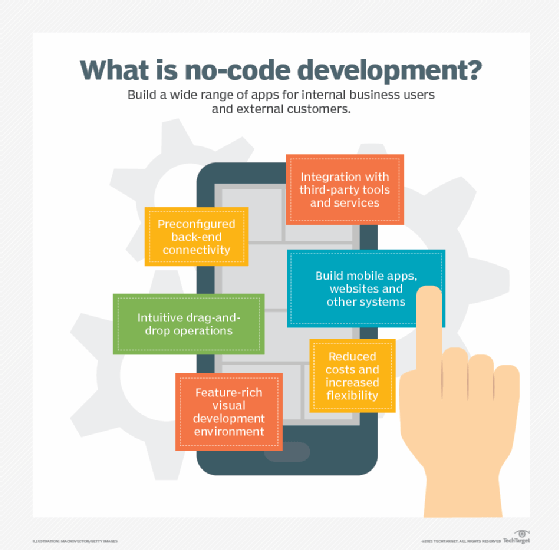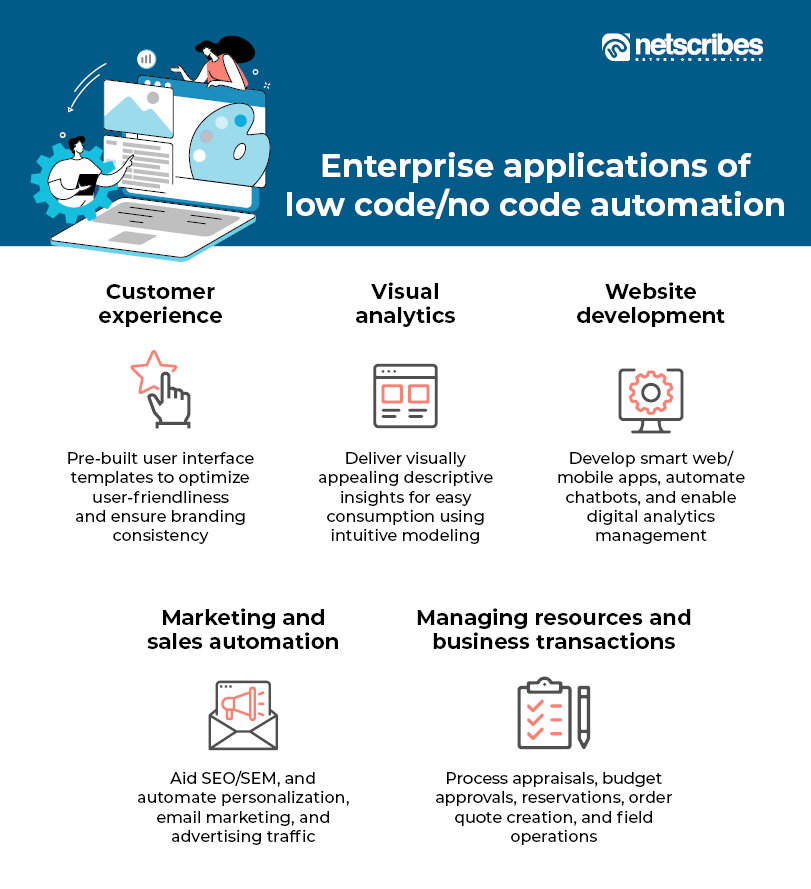Top Info To Selecting Low-Code Platform Examples
Top Info To Selecting Low-Code Platform Examples
Blog Article
In Terms Of Speed Low-Code Software Offers A Variety Of Advantages.
Visual Development Environment:
Drag-and-Drop Interfaces: Low-code platforms provide visual tools for designing applications. Developers can make use of drag-and-drop elements to create applications quickly and without having to write a lot of code.
Pre-built Templates and Components: A lot of low-code platforms have pre-built templates and components, that allow developers to quickly create and prototype applications without the need to begin from scratch.
Reduced Coding Requirements:
Automated Generated Code: Lowcode platforms write the code base on the visual models that developers have created. This reduces manual coding, and speeds up the process of developing.
Reusable Parts: Developers will be able to reuse parts that are reusable across their projects, thereby reducing the amount of time needed to write and testing of code.
Streamlined Collaboration:
Low-code platforms include many tools that facilitate seamless collaboration between development teams. These include testing, version control, and deployment.
Citizen Development: Non-developers as well as business users can benefit from simple interfaces to help in the creation of applications, which helps reduce bottlenecks triggered by a shortage of professionals to develop applications.
Rapid Iteration and Prototyping:
Fast prototyping: Developers can create prototypes in a short time to validate concepts and get feedback. This can result in a faster iteration cycles.
Easy Modifications: Low-code development is oriented towards visuals, which makes it much easier to modify and upgrade applications. It also speeds the process of developing and improving applications in response to user feedback.
Pre-built Integrations:
API Integrations. A lot of low-code platforms have connectors designed for the most the most popular APIs and other services. This could speed up the process of integrating systems.
Data Integration: The instruments that are built into the software simplify and accelerate the process of linking databases, other data sources, and applications.
Deployment Scaling
Many low-code platforms provide an option to deploy applications in one click which can reduce the time and effort needed to set up applications.
Cloud-based Platforms: Cloud-based platforms that have low-code capabilities can manage the infrastructure and scale, which means developers can focus on application logic and function instead of the logistics of deployment.
Overall, the benefit of developing applications using low-code in terms of speed lies in the ability of it to automatize and simplify many aspects of the development process. This allows faster delivery of applications and quicker adaptation to changing requirements. View the most popular Low-code Platform for application development blog for website advice including application modernisation, application development platforms, develop mobile application, cross platform mobile dev, azure sql server, application modernization software, paas service, cross platform mobile development, cross platform mobile dev, mobile development platforms and more.
Cost-Effectiveness Is One Of Many Advantages Of Developing Applications Using Low-Code.
Low-code development has many benefits in terms of cost-effectiveness. This is a great option for businesses that want to reduce their development budgets, but still delivering high quality applications. These are the major benefits reduced costs for development:
Lower Coding Requirements: Low coding platforms eliminate the requirement to code by hand which saves developers time and money. This results in less labor costs.
Reduced Developer Resources: Because low-code is quicker and easier to develop, fewer specialized developers will be required. This can drastically reduce costs of staffing and hiring.
Faster Time to Market
Accelerated Development Cycle: Visual tools for low-code platforms and components facilitate rapid application creation, which allows companies to launch their new products quicker. This will result in faster revenue growth and better standing in the market.
Rapid prototyping: By constructing and testing prototypes quickly companies can cut down on the amount of time they invest in the development stage and allow for quicker revisions based on user feedback.
Lower Maintenance Costs:
Because of their modular architecture and standardised components, low-code platforms typically simplify the maintenance of applications. Maintenance and support costs are cut.
Automated Updates: A lot of low-code software platforms manage patches and updates automatically and ensure that applications are secure and up-to-date, without the need for extensive manual intervention.
Efficient Resource Utilization:
Contributions from Non-Developers: Low-code platforms enable people who are not developers to participate in the process of development. This democratization enables companies to benefit from the skillsets of a wide range of employees.
Optimized IT Resource Use IT departments will be able to concentrate on strategic initiatives, instead of getting bogged down by routine tasks of development. This will boost overall productivity and efficiency.
Scalable Pricing Models
Subscription Pricing: Many platforms with low-code support flexible pricing models that are based on subscriptions that are scaled in accordance with the usage. This gives businesses the capability to adapt their spending according to the growth of their business and its needs without incurring large upfront costs.
Pay-as-you-go: Certain platforms provide pay-as-you-go options. This allows businesses to only pay for the resources they actually use. This is especially useful for small and new businesses with limited budgets.
Reduction in Third-Party Software Fees:
Built-in Functionalities: Low code platforms come with many built-in features and integrations, which eliminate the need for third-party software and tools. The cost of subscriptions and licensing charges are also reduced.
Integrations pre-built: These pre-built systems and services integrate with popular services, which reduces the requirement for custom-designed software, which saves time and cost.
ROI Improved:
A faster return on investment: The combination of speedy development, lower cost, and faster time to market means businesses are able to get a quicker ROI (ROI) for their applications.
Enhanced Agility - Businesses are able to quickly adjust to changes in the market and to changing customer demands. This allows them stay current and take advantage of opportunities that come up.
Train for More for
User-Friendly Interfaces: The intuitive interfaces and user-friendly functions of low-code platforms reduce the learning curve thus reducing the need to conduct intensive training.
Accessible Resources Low-Code Platforms: Many low-code platforms have comprehensive instructional materials, tutorials and support for community members, thereby cutting the need for formal training and the associated expenses.
Streamlined Collaboration:
Collaboration Tools: These tools enhance communication and coordination between teams, resulting in better processes for development and reduced overhead.
Unified Development Environment : A unified environment simplifies work flows and reduces the costs of managing multiple tools and platforms.
In general, low-code apps are cost-effective due to their ability to lower the cost of development and maintenance, to accelerate time-to-market, to optimize the use of resources, and to provide flexible pricing. These elements provide huge economic rewards for businesses. Low-code is a fantastic option for businesses that want to increase budgets while still being able to develop robust, scalable and high-quality software. Take a look at the top rated Enterprise application development with Low-code Platform info for site examples including driver jdbc, microsoft azure sql, application modernisation, application development platforms, low code platforms, push notifications, cross platform mobile app development, develop mobile application, low code platforms, rapid application design and more.
In Terms Of Support For Vendors And Community Involvement, Low-Code Development Can Bring Many Advantages.
Low-code applications development platforms can be a fantastic option to obtain support from the vendor as well as community involvement. Both of these aspects are essential to ensure the success of your implementation as well as ongoing maintenance of the application. Here are a few main benefits: Vendor support
Comprehensive Technical Support:
Support Teams with Dedicated Support: Many low-code platforms provide access to dedicated support teams who can assist with technical issues, troubleshooting and guidance, ensuring that any problems are resolved quickly.
24/7 Support Certain vendors are accessible around the clock and this is helpful for companies operating in different time zones.
Training and Onboarding
Structured Training: A number of companies offer structured training, including webinars, tutorials, and certification classes to aid users in becoming familiar with their platform.
Customized Onboarding : Many providers offer customized onboarding that help new customers to integrate the platform and tailor it to meet their individual requirements.
Regular Updates and enhancements:
Continuous Improvement : Low-code platforms providers often release periodic upgrades which include new features, performance enhancements and security patches. These updates make sure that their platform is current and secure.
Feedback Integration: Vendors include user feedback in their design cycles to ensure the platform is constantly evolving to meet the evolving needs of its users.
Comprehensive Documentation:
User documentation in detail Users will find solutions to their questions by referring to a detailed and organized guide that covers every aspect of the program starting from its basics to more sophisticated customisation.
API References In-depth API documentation enables developers to create custom applications and integrate low-code platforms with other platforms.
Professional and Consulting Services
Expert Consulting: A lot of firms offer consulting services that assist users in complex design and implementation, as well as strategic planning.
Custom Development Services: A few vendors provide custom development services to build specific features or integrations that are not available out-of-the-box.
Community Support
Active User Community:
Forums and Discussion Panels Many Low-code platforms feature vibrant online communities, which allow users to ask questions, discuss solutions, and collaborate with one another on the best practices.
User Groups & Meetups User Groups and Meetups: Local or virtual groups and meetings offer opportunities to network, learn and sharing knowledge.
Knowledge sharing and collaboration
Community-Contributed Resources: Users often share templates, modules, and extensions that they have developed, which can be reused or adapted by others, accelerating development and innovation.
Crowdsourced Solution Finding: The collective experience and wisdom of a group could be a great resource for finding solutions to complex problems.
Development and learning:
Community-Led Learning: Many communities hold workshops, training sessions, and webinars, which are usually run by experienced users who are able to provide insight and advanced techniques.
Online Tutorials and Courses Community members frequently create and share online tutorials, courses, and how-to guides, making better educational resources available to all users.
Feedback and Influence
Forums for Product Feedback: These forums usually provide feedback to the vendor which may influence the design of new features and enhancements.
Beta Testing Programmes Members of the community who are active may be able to participate in beta testing programs. This gives them the first glimpse of the latest features, as well as a chance to help shape the evolution of the platform.
Recognition and Support
A lot of vendors have communities recognition programs like MVP programs (Most Valuable Professional) that recognize the contribution of those who are active in their communities.
Peer Support Community members typically offer support to other members by sharing their knowledge and offering advice for those who aren't as skilled. This creates a supportive friendly and supportive environment.
Overall, the combination of robust vendor support and an active connected community offers an entire support network for development of low-code applications. The users will benefit from the experience and resources to develop, deploy and maintain their application.